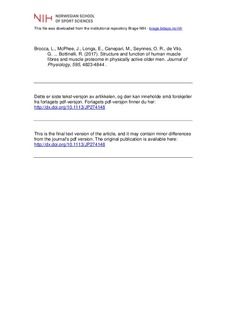Structure and function of human muscle fibres and muscle proteome in physically active older men
Brocca, Lorenza; McPhee, Jamie; Longa, Emanuela; Canepari, Monica; Seynnes, Olivier R.; de Vito, Giuseppe; Pellegrino, Maria A.; Narici, Marco; Bottinelli, Roberto
Journal article, Peer reviewed
Accepted version
Permanent lenke
http://hdl.handle.net/11250/2560818Utgivelsesdato
2017Metadata
Vis full innførselSamlinger
- Artikler / Articles [2119]
Sammendrag
Contradictory results have been reported on the impact of ageing on structure and functions of skeletal muscle fibres, likely to be due to a complex interplay between ageing and other phenomena such as disuse and diseases. Here we recruited healthy, physically and socially active young (YO) and elderly (EL) men in order to study ageing per se without the confounding effects of impaired physical function. In vivo analyses of quadriceps and in vitro analyses of vastus lateralis muscle biopsies were performed. In EL subjects, our results show that (i) quadriceps volume, maximum voluntary contraction isometric torque and patellar tendon force were significantly lower; (ii) muscle fibres went through significant atrophy and impairment of specific force (isometric force/cross-sectional area) and unloaded shortening velocity; (iii) myosin/actin ratio and myosin content in individual muscle fibres were not altered; (iv) the muscle proteome went through quantitative adaptations, namely an up-regulation of the content of several groups of proteins among which were myofibrillar proteins and antioxidant defence systems; (v) the muscle proteome went through qualitative adaptations, namely phosphorylation of several proteins, including myosin light chain-2 slow and troponin T and carbonylation of myosin heavy chains. The present results indicate that impairment of individual muscle fibre structure and function is a major feature of ageing per se and that qualitative adaptations of muscle proteome are likely to be more involved than quantitative adaptations in determining such a phenomenon. Structure and function of human muscle fibres and muscle proteome in physically active older men
Beskrivelse
I Brage finner du siste tekst-versjon av artikkelen, og den kan inneholde ubetydelige forskjeller fra forlagets pdf-versjon. Forlagets pdf-versjon finner du på wiley.com / In Brage you'll find the final text version of the article, and it may contain insignificant differences from the journal's pdf version. The definitive version is available at wiley.com
Tidsskrift
Journal of PhysiologyBeslektede innførsler
Viser innførsler beslektet ved tittel, forfatter og emneord.
-
Pelvic floor muscle function in pregnancy and after childbirth and the effect of postpartum pelvic floor muscle training on urinary incontinence in women with or without major defects of the levator ani muscle
Hilde, Gunvor (Doctoral thesis, 2014)Background: Urinary incontinence (UI) is highly prevalent in the female population and strongly associated with pregnancy and childbirth. The pelvic floor muscles (PFM) play an important role in pelvic organ support and ... -
DNA methylation across the genome in aged human skeletal muscle tissue and muscle‑derived cells: The role of HOX genes and physical activity
Turner, Daniel C.; Gorski, Piotr Patryk; Massar, Mohd Firdaus; Seaborne, Robert A.; Baumert, Phillipp; Brown, Alexander D.; Erskine, Robert M.; Dos-Remedios, Ian; Voisin, Sarah; Eynon, Nir; Borisov, Oleg; Larin, Andrey; Semenova, Ekaterina A.; Popov, Daniil; Drust, Barry; Owens, Daniel J.; Ahmetov, Ildus I.; Sharples, Adam; Kitchen, Mark O.; Sultanov, R. I.; Generozov, Edward V.; Stewart, Claire E. (Peer reviewed; Journal article, 2020)Skeletal muscle tissue demonstrates global hypermethylation with age. However, methylome changes across the time-course of differentiation in aged human muscle derived cells, and larger coverage arrays in aged muscle tissue ... -
Increased Plin2 expression in human skeletal muscle is associated with sarcopenia and muscle weakness
Conte, Maria; Vasuri, Francesco; Trisolino, Giovanni; Bellavista, Elena; Santoro, Aurelia; Degiovanni, Alessio; Martucci, Ermanno; D'Errico-Grigoni, Antonia; Caporossi, Daniela; Capri, Miriam; Maier, Andrea B.; Seynnes, Olivier R.; Barberi, Laura; Musaro, Antonio; Narici, Marco V.; Franceschi, Claudio; Salvioli, Stefano (Journal article; Peer reviewed, 2013-08-15)Human aging is associated with a progressive loss of muscle mass and strength and a concomitant fat accumulation in form of inter-muscular adipose tissue, causing skeletal muscle function decline and immobilization. Fat ...
